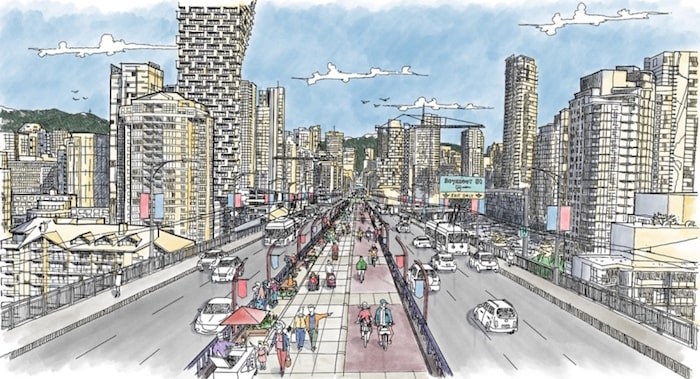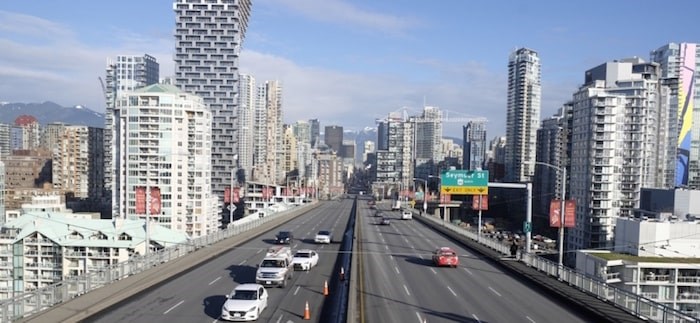The eight-lane Granville Bridge is “one of the most glaring barriers in Vancouver’s pedestrian and cycling networks,” says a city staff report going before city council Wednesday.
The report recommends council direct staff to begin a public discussion to finalize a design for the Granville Bridge that would reallocate at least two centre traffic lanes on the 1954-era span to create a path for pedestrians, cyclists and people who require wheelchairs.
 Design concept for a path on the Granville Bridge. Image courtesy City of Vancouver.
Design concept for a path on the Granville Bridge. Image courtesy City of Vancouver.
City staff says a survey is also underway to determine whether it would be feasible to install an elevator that would take pedestrians, cyclists and others from bridge deck to Granville Island, and vice-versa. Public seating and art are also anticipated on the path.
“The goal of this project would be to create a safe, comfortable, accessible and enjoyable walking, rolling and cycling experience across the bridge, which would seamlessly connect major destinations and link to the city’s broader network,” the report said of the proposed “Granville Bridge Connector,” which would connect to the Arbutus Greenway at the south end of the bridge.
 Current design of the Granville Bridge. Image courtesy City of Vancouver
Current design of the Granville Bridge. Image courtesy City of Vancouver
The concept isn’t new and was revealed in 2012 when council adopted the Transportation 2040 Plan, which identified the Granville Bridge and other spans across False Creek as needing upgrades to address gaps in the city’s walking and cycling network.
The Burrard Bridge and Cambie Bridge have both had upgrades—namely removal of traffic lanes, the addition of cycling lanes and redesign of intersections—to accommodate pedestrians and cyclists. The staff report noted cycling increased by about 30 per cent between 2013 and 2018 on the Burrard Bridge.
“Southbound motor vehicle times have reduced by over a minute and travel time reliability has improved,” the report added. “Safety for all modes is also expected to have greatly improved.”
On the Cambie Bridge, “early data suggests that conflicts between people walking and cycling on the bridge have decreased [a key driver of the project], and that there has been no significant impact on motor vehicle travel time.”
The report to council comes as work is already underway to rehabilitate and seismically upgrade the Granville Bridge, with $25 million approved in the city’s current capital budget plan. Coordinating the work with a new path for pedestrians and cyclists will reduced the “overall costs and impacts of the projects,” the report said.
The Granville Bridge was built in 1954 and designed to connect to high-speed, high-volume freeways that were never built. The result of that design is the bridge has “significant excess road capacity,” with the report noting “even if each of the streets feeding the bridge were full, the bridge itself would be relatively empty. It carries a similar traffic volume to Burrard Bridge, which has half the number of vehicle lanes.”
The city’s renderings of the concept for Granville Bridge show three traffic lanes to remain on both sides of the bridge at mid-span. But the report suggests “up to four motor vehicle lanes could be reallocated towards a pathway, and there would be enough capacity to accommodate motor vehicle traffic. Connections at either end of the bridge would be redesigned to ensure safety and comfort while ensuring reasonable travel times for all modes.”
The report lists “significant challenges” with the current design of the Granville Bridge, including “narrow and uncomfortable” sidewalks, no buffer for high-speed traffic and crosswalks without signals on vehicle ramps and loops that were designed to link with freeways.
City council meets at 9:30 a.m. Wednesday at city hall to hear staff’s report.


